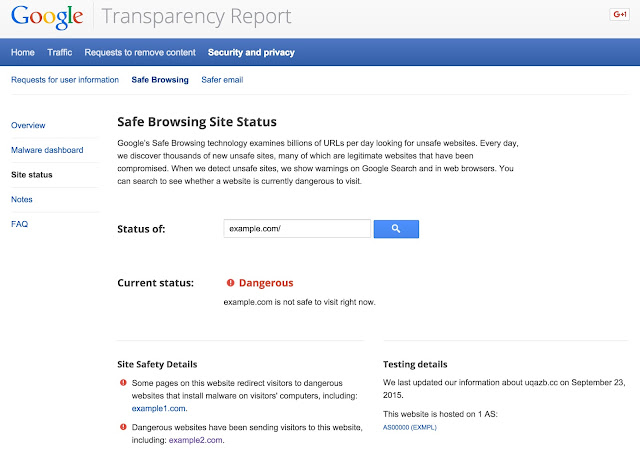You’re browsing the web, checking out the latest news on your favorite band, when suddenly you see a red warning screen: “The site ahead contains malware.” These warnings aren’t new—since 2006, Google Safe Browsing has shown them when you navigate to an unsafe site. The warnings protect you from harms caused by unsafe sites, such as malware infections and phishing attacks. But it hasn’t always been clear why a specific website triggers a warning, and you may want to learn more.
To demystify these warnings, we’re launching a Site Status section in the Transparency Report. The next time you come across a Safe Browsing warning, you can search for the blocked website in the Transparency Report to learn why it’s been flagged by our systems.
The new Site Status section of the Transparency Report replaces our previous Safe Browsing diagnostic page. It includes a clearer interface and simpler explanations of the issues, such as details for sites that host unwanted software. We’ve added it to the Transparency Report so that the Safe Browsing section of the report is a one-stop shop for information to help you understand what Safe Browsing is and how it works.
If a favorite website shows up as “dangerous,” it’s often due to user-uploaded bad content or a temporary malware infection. The Site Status will return to normal once the webmaster has cleaned up the website. To help speed up this process, we automatically give the webmaster a heads-up about the problem via Search Console; if you use Google Analytics, we’ll also warn you there if your site has malware on it. (Webmasters, check the help center to learn how to remove malware from your websites.)
We’re constantly working to keep users safe and informed online. Visit the updated Site Status section in the Transparency Report to experience it yourself.
Posted by:
Adrienne Porter Felt, Chrome Security Engineer and Warning Wizard
Emily Schechter, Safe Browsing Program Manager and Menace to Malware
Ke Wang, Safe Browsing Engineer and Developer of Defense










